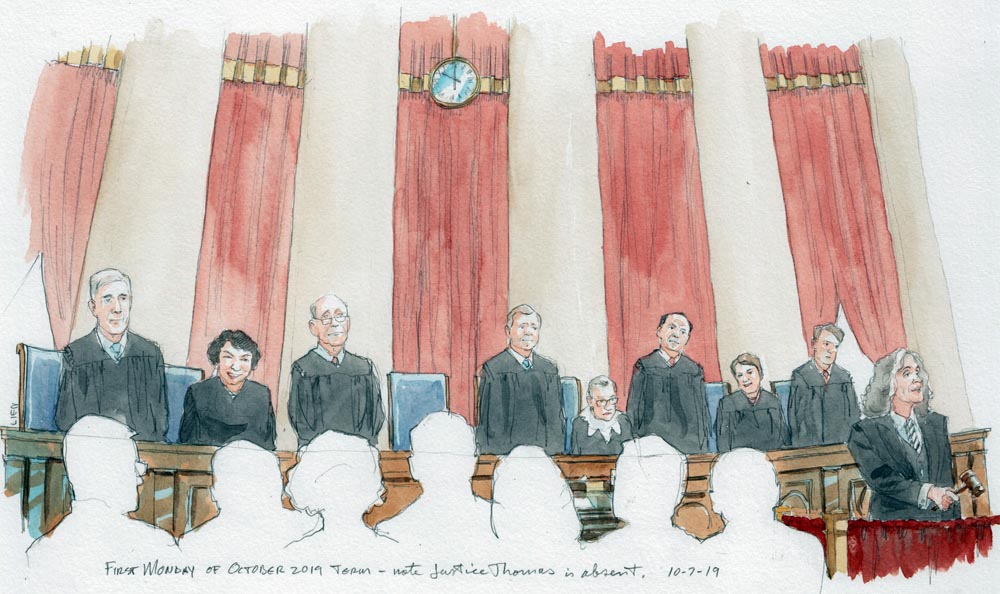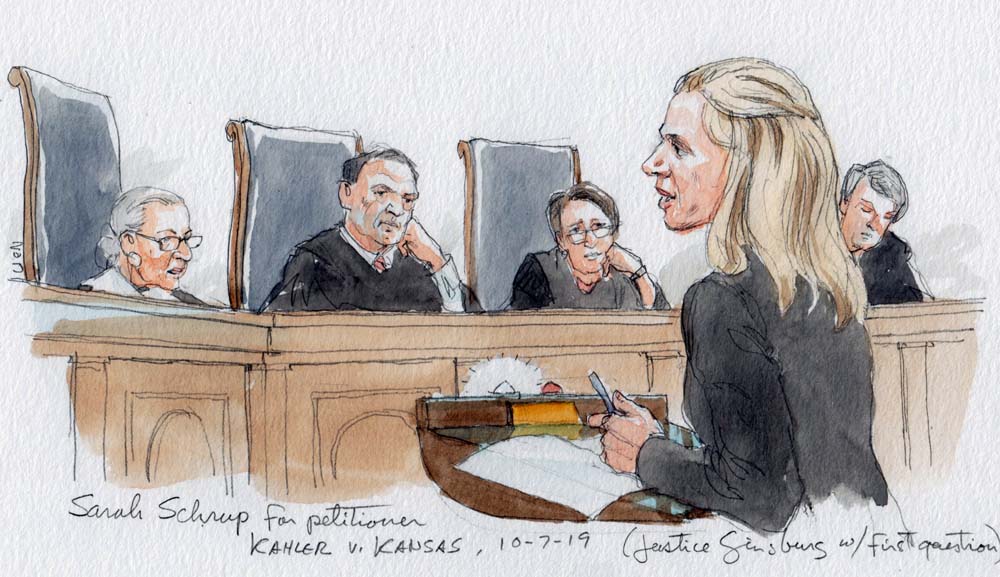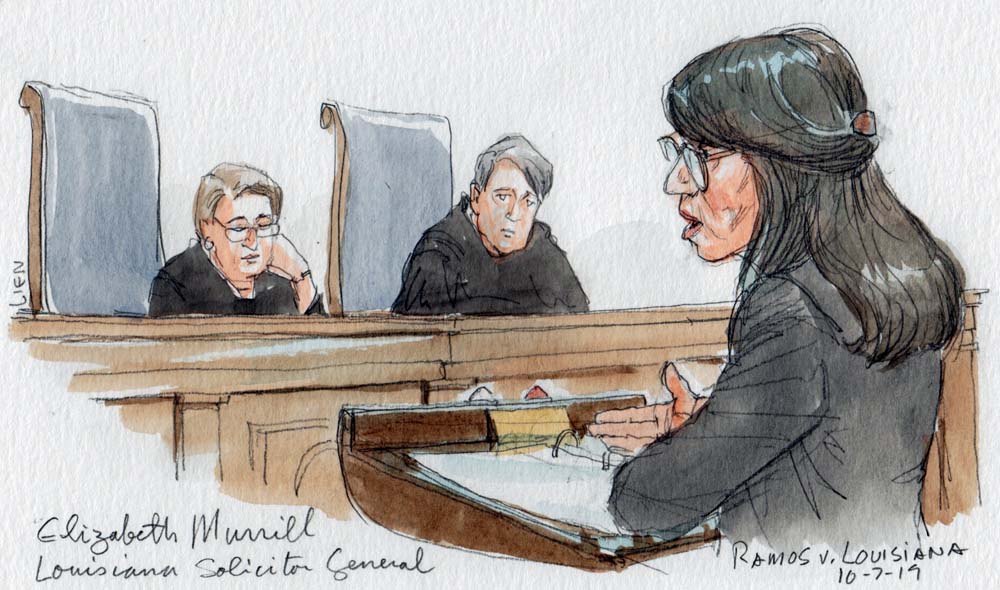A “view” from the courtroom: Two-minute warning

on Oct 7, 2019 at 5:07 pm

There is an air of anticipation as spectators gather in the courtroom for the first day of the new term. Already, there are people in line for Tuesday’s arguments on whether Title VII covers sexual orientation or transgender status in the workplace. In the cafeteria this morning, I meet a recent law school graduate who is fourth in line and is taking a breakfast break. (Apparently, the members of the overnight line look out for each other and allow for restroom and meal breaks.)
But before we get to Tuesday, we have to get through a busy first day, which includes two cases in the morning and a rare afternoon argument. The courtroom is full this morning, and it is slightly jarring to see Michael Dreeben, who left the Justice Department earlier this year after 30 years of service, including as deputy solicitor general specializing in criminal cases, sitting in the second row of the public gallery.
In the justices’ guest box, three spouses are here for opening day. Jane Roberts, the wife of Chief Justice John Roberts; Martha-Ann Alito, the wife of Justice Samuel Alito; and Ashley Kavanaugh, the wife of Justice Brett Kavanaugh. Only Martha-Ann Alito will hang in there for all three arguments.
The court takes the bench at 10 a.m., and Justice Clarence Thomas is absent. There is some brief murmuring in the press section. Is he recused from the first case for argument and we somehow forgot? The chief justice will explain the absence momentarily.
But first, Roberts performs the ceremonial act of closing out the October 2018 term and announcing that the “October 2019 term is now convened.”
Thomas is unable to be present today because “he is indisposed due to illness,” the chief justice says. (The Public Information Office will later pass along that Thomas is home today with flu-like symptoms.) Roberts announces that Thomas will participate in today’s cases on the basis of the briefs and the transcripts or recordings of the oral arguments. That tactic was practiced most recently by Justice Ruth Bader Ginsburg last term, when she was recuperating from lung surgery and missed the January sitting.
Roberts has two more preliminary matters.
“I would like to note that August 3, 2019, marked the 25th anniversary of the day our colleague Justice [Stephen] Breyer took the judicial and constitutional oaths as a new member of this court,” the chief justice says. “On behalf of the court, I congratulate you, Justice Breyer, on your distinguished service, and I look forward to sharing many more years with you in our common calling.”
As we have noted before, the script changes from the 25th to the 30th anniversary, when the chief justice drops the presumption that there will be “many more years” of service by the particular justice.
Breyer launches into a grin as the chief justice speaks, and he slightly nods his head as the salute concludes.
Finally, Roberts devotes several minutes to paying tribute to the late retired Justice John Paul Stevens, who died July 16 at age 99.
Justice Stevens’ “kindness, humility, independence, and wisdom have left us a better court,” the chief justice says. “His commitment to justice has left us a better nation.”
“Justice Stevens was a dear colleague and friend,” Roberts adds. “Our condolences go out to his children, his extended family, and his many admirers. At an appropriate time in the spring, the traditional memorial observance of the court and bar will be held in this courtroom.”
One thing the chief justice does not mention from the bench is the new provision inserted last week into the “Guide for Counsel Arguing Cases” before the court. In a relatively rare alteration to longstanding courtroom procedure, the provision explains two changes that begin today.
“The Court generally will not question lead counsel for petitioners (or appellants) and respondents (or appellees) during the first two minutes of argument,” the guide says. “The white light on the lectern will illuminate briefly at the end of this period to signal the start of questioning. Where argument is divided and counsel represents an amicus or an additional party, the white light will illuminate after one minute.”
The other change is that counsel may now reserve as much as five minutes for rebuttal (in a normal half-hour argument, or up to three minutes in 20-minute argument) by informing Marshal Pamela Talkin by 9 a.m. on the morning of argument. This has prompted another procedural change for the set of lights on the lectern. The lawyer’s white light will now come on at the 20-minute mark, and the red light will illuminate at the 25-minute mark. The lawyer then will have reserved a full five minutes for rebuttal.
This replaces a system in which counsel was advised to reserve time for rebuttal when the white light came on (which meant five minutes left in his or her argument under the old system). But that system was a bit scattershot, and the lawyers were often subjected to continued questioning from certain justices, sometimes to the exasperation of the chief justice.
The changes were announced somewhat quietly by the court on October 3. In the days since then, some experienced Supreme Court litigators have told me they welcome the new procedure allowing counsel to speak uninterrupted at the beginning of argument, a variation of which is used in at least one federal appeals court. Others either didn’t like it or didn’t expect it to last for long.
The first test of the new system comes in Kahler v. Kansas, about whether the Eighth and 14th Amendments permit a state to abolish the insanity defense.
Sarah Schrup of the Supreme Court Practicum at Northwestern University’s law school is representing the petitioner, James Kraig Kahler, who was convicted of murdering four relatives and is challenging Kansas’ lack of an affirmative defense of insanity.
Schrup delivers her practiced opening, and the justices obediently observe their new procedure. At two minutes, Talkin turns on the white light for a few seconds. As soon as it flashes off, Ginsburg is first to interrupt Schrup, who is in the middle of saying she would “like to now turn back to history …”
“Well, before you do that …” Ginsburg says, asking a longish question about due process. (Amy Howe has this blog’s main account of the arguments in Kahler and a second criminal case from today, Ramos v. Louisiana.)
Toby Crouse, the solicitor general of Kansas, throws the first curveball in the new system. He is in the second minute of his uninterrupted opening defending his state’s mens rea system when he says, “We believe that the state supreme court judgment in Kansas should be affirmed. And so unless there are additional questions this Court would have, I’d like to first turn to the answer” of Schrup to a question from Alito.
Just a minute there, general. The court undoubtedly does have some additional questions, but the white light hasn’t come on yet. A few seconds later, it does, and Justice Sonia Sotomayor is ready to jump out of the gate, even before the light is off.
“I understand what you’re saying, but I have a problem because …” she starts off with Crouse.
Elizabeth Prelogar, an assistant to the U.S. solicitor general, has 10 minutes to argue in support of Kansas as an amicus, so that means under the new system she gets one minute of uninterrupted argument. After the white light, the justices even let her go on for a few seconds more before starting their questions.
When Schrup returns to the lectern for her five minutes of rebuttal time, she speaks uninterrupted for a few of those minutes, before trying to wrap up with, “If this Court has no further questions, we would ask you to please reverse the case.”
Alito takes this as a cue to ask a question during rebuttal time. “Well, I would ask you a question, if you’ve finished your — the comments you want to make.”
They continue a colloquy until the red light comes on to signal the end of the argument while Alito is still speaking.
“May I finish my sentence, Mr. Chief Justice?” Alito says, to laughter in the courtroom.
“Certainly,” Roberts says.
Alito continues with a question about 18th-century and early 19th-century understandings of how the mind works. Schrup dutifully asks the chief justice if she may answer.
“You may,” he says, and Schrup answers quickly.
The first case is submitted. The second case provides an answer to a question at least one advocate asked me. Does reserving five minutes of rebuttal time mean you only get five minutes? Or, if you happen to wrap up your main argument in fewer than 25 minutes, do you get the total time remaining?
I have seen cases in which an assistant to the solicitor general wrapped up her top-side argument very quickly and was told as she returned to the lectern that “you have 15 minutes for rebuttal.” She didn’t use all that time.
In Peter v. Nankwest Inc., a dry, procedural patent case and the second case for argument today, the answer to the question about using more than five minutes of rebuttal time comes when Deputy Solicitor General Malcolm Stewart ends his main argument early.
“Mr. Stewart, you have six minutes remaining,” Roberts says to the deputy solicitor general.
The third argument of the day is in Ramos v. Louisiana, about whether the 14th Amendment fully incorporates against the states the Sixth Amendment’s requirement for unanimous jury verdicts.
The court has removed the second set of counsel’s tables that were here just this morning, providing more seats in the bar section. They aren’t really needed, because the bar section is only about a third full.
As is often evident in the second and third arguments of the day, the overall vibe in the courtroom is more relaxed. The justices (minus Thomas) return to the bench promptly at 1 p.m. Jeffrey Fisher of the Stanford Law School Supreme Court Litigation Clinic is representing Evangelisto Ramos, who was convicted of second-degree murder of a New Orleans woman by a jury vote of 10-2.
Sitting at the petitioner’s table is Pamela Karlan, also of Stanford, who will be arguing for the gay employees in tomorrow’s Title VII cases. Meanwhile, at the respondent’s table, Washington lawyer William Consovoy, who is busy with any number of high-profile issues, including some involving President Donald Trump, is with the team from the state of Louisiana.
Fisher is an experienced Supreme Court litigator, and during the first case today, we noticed something when he was sitting in the back row of the bar section. (There is no third set of tables for days with three arguments.) Fisher had several pages of notes affixed to a long, legal-size manila folder. The folder could be opened to two pages or folded to one. When Fisher moves to the lectern for his argument, it becomes evident that the legal-size folder does not fit well on the wooden platform. (The “Guide for Counsel” advises, “Please note that a legal sized pad does not fit on the lectern properly.”) Nevertheless, Fisher’s extra-long folder seems to work for him.
Two minutes into Fisher’s argument, the white light briefly flashes. No one immediately interrupts Fisher. After another minute or so, Roberts breaks in with a question.
Elizabeth Murrill, the solicitor general of Louisiana, was the lawyer most in rhythm with the new procedures. She wraps up her uninterrupted two minutes by calling for a particular Supreme Court precedent to be affirmed.
“And I’m happy to take questions,” she says, at the exact moment the white light flashes before her.
The justices had plenty of questions for her. But at the end of a long day of arguments, everyone seems reasonably happy with a minute change in tradition.




